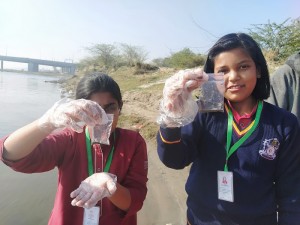Class 6 Visit to Yamuna Walk
The Indian school organised a Yamuna walk for the students of class VI as a part of the Nat Geo project on 14 February 2020. The motto underlying this mega initiative was ingraining a sensitivity amongst students on the need to reduce water pollution. The drive was organised with the guidance of the teachers of the Eco Club of our School.
The activities conducted during the walk highlighted the importance of a green and clean Delhi. The first stop was the Najafgarh Nallah which is the largest drain in South Delhi. This used to be a tributary (called the Sahibi River) of the Yamuna until about a decade ago. The water in this drain is categorised as E- class which means it is not even fit for bathing animals! Students collected samples of this water for its treatment at School.
The second stop of the walk was the Khutsai Ghat. Here students saw how the water of the Yamuna merges with water flowing from the Najafgarh drain. One could see that there was no sign of aquatic life. Students also observed that the river was filled with pooja waste. They were shocked to learn that even untreated water from industries nearby is released into the stream.
The resource person explained the WWTP (Waste Water Treatment Plant) for the benefit of the young visitors. He said that these large plants treat waste water was before sending to the nearby water bodies or for recycling. Waste water includes biological, physical and chemical matter and hence involves biological, physical and chemical processes of removal of the contaminants, he explained.
[gallery link="file" order="DESC"]
The physical and biological process of treatment of water includes:
1. Separation of Large Objects from Sewage Water
2. Seperation of Sand and Dirt
3. Removal of Solids
4. Suspended Sludge Removal
The treated water contains lower levels of impurities and suspended matter. This water can be dumped safely into a water body or under the ground. Nature further cleans it up. The resource person also explained the chemical treatment of waste water. He said that harmful chemicals remain present in water even after treating it physically and biologically. Such chemicals are removed by using disinfectants such as Chlorine and Ozone. Often chlorine gas or ozone gas is introduced in such water which then purifies it chemically.
The students took a pledge to keep the river clean and the water potable. They promised to raise awareness about the Yamuna in their communities.
The drive opened the eyes of the students on the condition of the river and the desperate need for saving it and the biodiversity associated with it. They also learned about the treatment of water.
It was an enriching experience for the students as well as their teachers.
For more pictures...click here













